Many times, we need to put our Windows computer into Sleep Mode, so that we can instantly wake and use it when we need it, without losing the time required for booting it. But sometimes, Windows will not Sleep. If Windows 11/10 refuses to sleep or won’t go into sleep mode, this post will show you how to fix the Sleep Mode not working problem.
Windows 11/10 does not Sleep
You may experience one of the following scenarios:
- PC wakes immediately after you put it to sleep.
- PC randomly or unexpectedly wakes after sleep.
- PC does not go to sleep. Instead, it stays awake.
Recently, we have seen how to enable or disable password requirements at wake up. After upgrading one of my systems, I found that the sleep functionality was no longer working on that system.
Windows Sleep Mode not working
If Windows 11/10 does not sleep, then you can try the following suggestions:
- Check if you have a sensitive mouse
- Configure or Reset Power Plans to default
- Rollback or Update drivers
- Run Power Troubleshooter
- Check Multimedia Settings
- Check Network Adapters settings
- Disable Intel Driver & Support Assistant.
1] Check if you have a sensitive mouse
If your mouse is sensitive, then a vibration could also wake up your PC. It would then be best to Off your mouse after you put your PC to Sleep.
Alternatively, you may open Device Manager > Expand Mice and other pointing devices > Right-click on the mouse > Properties > Power Management tab and uncheck Allow this device to wake the computer > Click OK.
2] Configure or Reset Power Plans to default
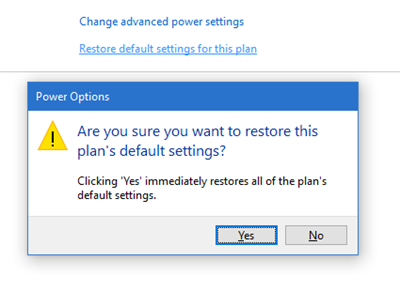
In order to fix this issue, we need to correctly configure Windows Power Plan settings. You need to open Power Options and check the Sleep settings when on Battery and when Plugged in. Also open Advanced Power Options and check the Sleep settings. Reset the settings to default and see.
Read: Computer making Notification sounds when Sleeping
3] Rollback or Update drivers
You may also update your driver – mainly Microsoft ACPI-Compliant Control Method Battery – to its latest versions. If you recently updated it, try a rollback.
You may want to also check up on your Graphics Drivers.
4] Run Power Troubleshooter
You need to open the Power Troubleshooter.
Once the Power Troubleshooter, you have to click Next option:

This will start the automatic detection and fixing of issues.
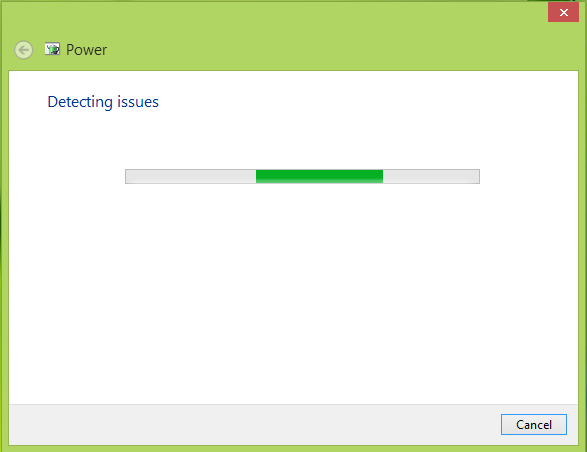
When the troubleshooting has been completed, you can click Close.

Now you can reboot the machine, after a restart, you’ll find that the issue is already fixed.
In Windows 10, you use the Windows Troubleshooters Settings page to access the Power Troubleshooter.
Related: Screen stays black after waking computer from Sleep Mode
5] Check Multimedia Settings
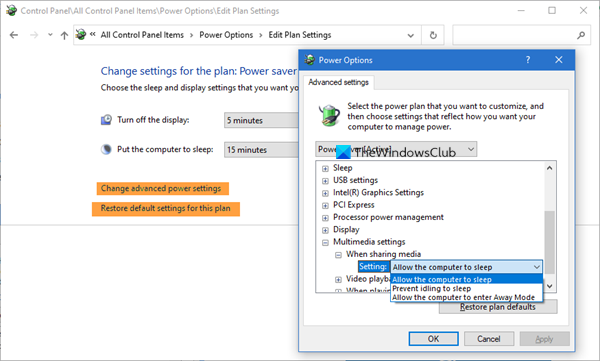
Open Settings > System > Power & sleep > Additional Power Settings.
Open Power Options and under Multimedia settings > When sharing media, ensure that the setting is for Allow the compute to sleep.
Click Apply > OK.
6] Check Network Adapters settings

- Open Device Manager
- Expand Network adapters section.
- Right-click on each of them one after the other
- Select Properties
- Uncheck Allow this device to wake the computer for each and click OK.
7] Disable Intel Driver & Support Assistant
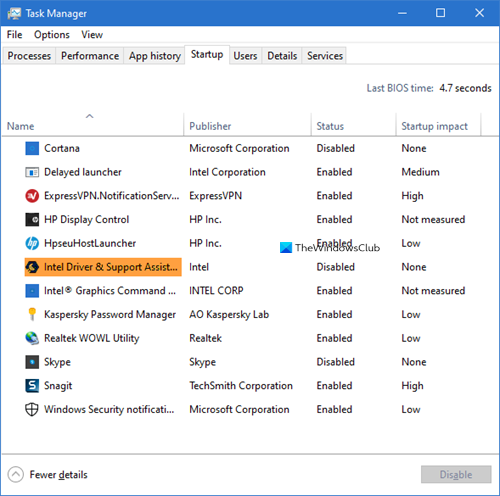
When I was facing this issue, I disabled Intel Driver & Support Assistant from the Task Manager > Startups tab, and it worked for me.
BONUS TIP:
If Windows 11/10 computer turns on by itself, run the following commands and see.
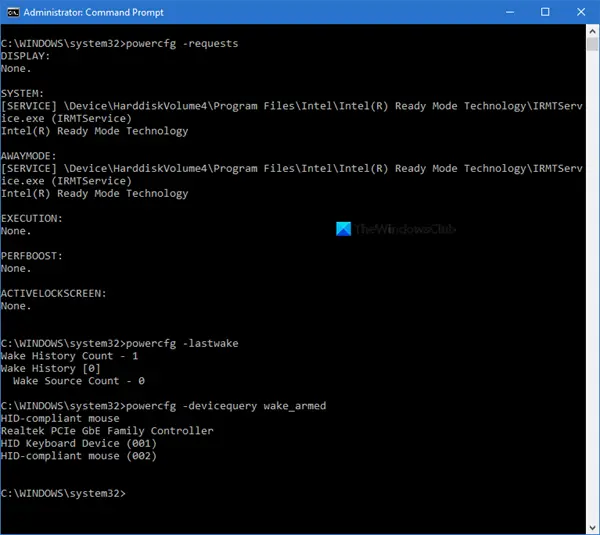
To know which applications are hindering the Sleep operation:
powercfg -requests
To disable this process, run this command:
powercfg -requestsoverride <TYPE>“<NAME>”<REQUEST>
To find out what prevented your laptop from going to Sleep:
powercfg -lastwake
To know all the devices which woke your PC:
powercfg -devicequery wake_armed
Read: What is a Wake source for Windows computer? Why did my PC wake up?
Sometimes, other problems related to Sleep Mode can appear in Windows. Well, these posts will show you how to fix such problems:
- Windows computer goes to Sleep too early
- Windows PC shuts down after manually going to sleep
- Hibernate or Sleep shuts down the computer running Windows
- Windows computer wakes from sleep automatically
These posts will show you the other ways you can manage Sleep on your PC:
- Wake up the computer from Sleep, at a particular time
- Windows will not wake up from sleep mode
- Prevent Computer from waking up from Sleep
- Prevent Hard Disk from going to sleep.
I hope you find the post useful!
Sleep is too long :/
Worked on my hp stream 7. Thank you so much.
Doesn’t fix sleep issue.
troubleshooter detects no issues, restarted still cant keep computer in sleep. guess i have to do a shutdown instead of sleep.. this is so annoying.
fixed my problem. thanks,
all the fix force users to use “balance power plan”, all other plans are useless then why don’t just remove them all… windows 8 sucks!
Sleep time too long issue fixed :)
Thanks for the tip!
Well listen to yourself you big overweight baby!!! You’re a mac lover, so why are you even using Windows (which by the way is far superior than a barrel of macintosh apples)!!!
It’s strange that my computer was not forced to use the “balanced power plan” at all but rather remained with the “High Performance!” And this fixed my issue perfectly.
Instead of crying and snorting, I’d suggest you take your Commodore 64 and buy a Tonka Toy!!!
Get out of bed earlier!
Thanks for shring this knowledge! I also learn some other tips about Sleep Mode Not Working in Windows 8.1, How to Fix It. I read it from http://www.windowspasswordsrecovery.com/win8-tips/sleep-mode-not-working-in-windows-8-1-how-to-fix-it.html
It’s kind of annoying that here we are in 2015 and Windows 8.1 still has problems with power management. This is an old problem that has been solved by other systems many years ago.
Also, this page is just as poorly thought-through. I came here because my Windows 8.1 PC does not go to sleep. I followed the instructions but did not get any solution. Then I saw the link on this page suggesting there was another page specifically for “Windows does not go to sleep.” But this link takes us to a page with other instructions that won’t work and a link “Sleep Mode is not working in Windows 8.1!…” to this page. Does anyone review this material before it is published?
Oh, and Robert Shuste … get a life.
I don’t know about anyone else but all the above solutions and many other suggestions have proven not to work for me. After several hours of testing and experimenting, the only solution which works for me is to ensure hybrid sleep is enabled and wake timers disabled in your advanced power plan settings.Then set turn off monitor to never and set your time for sleep, Mine is set for 10 minutes. Lo and behold my laptop now enters sleep every time.Tested and proven by sitting at my laptop for several hours with setting my time for sleep to 1 minute with monitor turn off set to never and observing if it consistently entered sleep mode after 1 minute. My laptop entered sleep every time. Apparently, now I could be wrong, having the monitor set to turn off with sleep is conflicting with sleep mode in windows 8.1. The monitor does not have to be set to turn off as it turns off anyway when computer enters sleep so try setting the monitor to turn off never and set your sleep to whatever suits your needs and tell me if this solutions works for you. It worked for me.
In response to my own reply, I neglected to mention, ensure your homegroup provider and listener are both stopped and disabled in services. I do not know if this makes a difference but mine were already disabled and stopped when I tried setting monitor to never turn off. So why tempt fate by re enabling them unless you need homegroup, lol. Personally, I do not need homegroup.
Thanks Leo, using you method above fixed my HP Folio 9470m w/ Windows 8.1 sleep timer problem.
This name-calling comment is rude and distasteful on this forum. Please refrain from doing this again. If you must hate people, keep it to yourself.
My apologies Standuncan.
Sometimes sleep mode issues are hardware related. I recently had to replace my power supply for this very reason. It would hibernate every time I told it to sleep. For ATX power supplies, Pin 9 is the one that keeps a small amount of power going to the motherboard while it is “powered down” or “asleep”… this is what allows for the ability of the machine to wake-on-lan, wake up when you move the mouse/keyboard, etc. I replaced the old power supply this past weekend (yes, the get age and go bad over time, we just never think about them, out of sight out of mind) and sure enough all is as it should be now.
Windows 8.1 Sleep Mode finally fixed! The two-step solution (for
me) was:
1.) Set the Windows screen saver to require me to enter password to log back
in.
2.) Power Options configuration: set the desired number of minutes for PC to go
to sleep.
Prior to this, I set two devices to not allow them to wake up the PC: HID
compliant mouse, and the Keyboard. It still wouldn’t automatically sleep, but
steps 1 and 2 above seem to have gotten it right.
The solution I found is not to select the “Never” option under “When to turn off the display” in Power Options. Selecting 5 hours fixes the “will not sleep when lid is closed” bug.
Absolutely worthless; reset my options for turning off display and sleep delay, but did nothing about powrprof.dll’s failure to sleep on command.